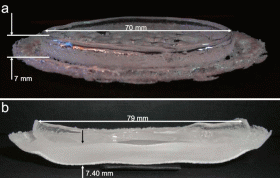January 29, 2009 feature
The Power of Light: Moving Macroscopic Amounts of Matter

(PhysOrg.com) -- Since 1970, scientists have been working with “optical tweezers” - lasers that move microscopic amounts of matter using forces originating from the light matter interaction. Now, for the first time, researchers have demonstrated that light-induced forces can move macroscopic amounts of matter, as well.
The German team, led by Jens Günster of the CiC Ceramic Institute Clausthal GmbH in Clausthal-Zellerfeld, Germany, in collaboration with researchers from the Deutsches Zentrum für Luft und Raumfahrt, Institute of Composite Structures and Adaptive Systems in Braunschweig, Germany, has recently published the achievement in a recent issue of Applied Physics Letters. The scientists described a phenomenon not yet observed: Under intense light irradiation, molten silicon powder particles (about 40 micrometers in diameter) can form macroscopic structures up to 7 mm high.
“We regard the fact that laser light can directly apply forces to a dielectric liquid on a macroscopic level as a finding of great significance,” Günster told PhysOrg.com. Those applied forces are direct, yet don’t require any physical contact with the liquid.
In experiments, the researchers used a CO2 laser to melt a pile of pure silicon powder, which has a melting temperature of 1713°C (3115°F). At its highest power output of 12 kW, the laser could melt the silicon powder almost instantaneously. However, the researchers lowered the power output to 9.6 kW to avoid excessive evaporation of the silicon. After a few minutes, most of the silicon melted into a liquid pool about 7 mm deep. Yet, before the melting, some of the partially molten silicon particles peeled off the surface, starting at the point of highest laser intensity. The matter curled into 7-mm-high protrusions parallel to the silicon’s horizontal surface, forming against gravity and surface tension, and even surviving the liquid state. When the scientists turned the laser off, the solid structures were preserved.
To explain this novel light-matter interaction, the researchers developed a model in which light-induced forces couple to the molten silica. They explain that, in order for light to move macroscopic amounts of matter and form surface protrusions, the material must have a low surface tension. The scientists performed the same experiment with silicon powder compacts (in which the powder particles are adhesively linked to each other by van der Waals forces, providing greater mechanical strength). But when heating the powder compacts with the laser, the researchers found that surface protrusions did not form, which is likely due to the powder compacts’ greater surface tension.
With the ability to control the light irradiation, the melting phenomenon could have applications in several areas, such as the mechanical manipulation of ceramics/glass melts directly by laser radiation, the initialization and control of self-organizing processes, and the styling/design of specific geometries. In the future, the researchers want to understand the interaction further.
“We are planning to show in more sophisticated experiments the nature of the laser matter coupling,” said Günster. He added that they also plan to investigate “laser-induced manipulation of piezoceramic materials and the design of new piezoceramic actuators.”
More information: Günster, J.; Oelgardt, C.; Heinrich, J.G.; and Melcher, J. “The power of light: Self-organized formation of macroscopic amounts of silica melts controlled by laser light.” Applied Physics Letters 94, 021114 (2009).
Copyright 2008 PhysOrg.com.
All rights reserved. This material may not be published, broadcast, rewritten or redistributed in whole or part without the express written permission of PhysOrg.com.





















